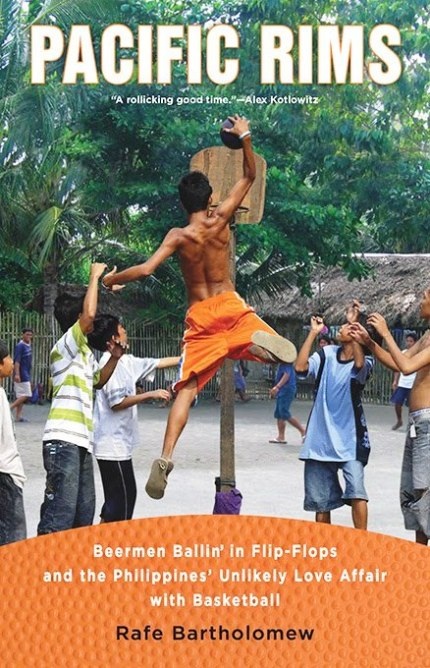Valencia, Negros Oriental, Philippines
But basketball rules. Filipinos have their own professional leagues and Filipinos religiously follow the NBA. My mother-in-law has an enormous DVD box-set of the San Antonio Spurs' past seasons that she watches over and over. Though she's a Filipino-American living in L.A., she was a fan of the game before she ever came to the U.S.
Some schools have gyms with wooden courts, or like New York City parks, outdoor cement or asphalt courts. Local governments build basketball facilities for their cities or towns. The basketball court is one of the centers of social life for the youth. The better the economic situation of the town, or at least the local government's connections, the better the basketball facilities. The well-off have large covered courts so the games can continue through the otherwise game-stopping sunny or rainy afternoons. Out in the countryside or in poor neighborhoods, the backboards and hoops are a bit more ingeniously hobbled together.
On a hot afternoon in rural Siquijor a few weeks ago, Joseph and I walked by a make-shift hoop next to a family's house. The backboard was constructed of old ill-fitting boards and the rim was obviously a home-made iron hoop, now all rusted and barely hanging on. I thought it looked like a country cartoon of a basketball goal. Oh, how quaint, I thought, an old abandoned basketball hoop. Late in the afternoon, when we walked by again, the court was filled with boys and girls from the area shooting hoops.
This past weekend, we were up in the nearby mountains for a cool retreat from the heat. Our camp was located near the end of a paved road and there were maybe ten houses nearby, enough to make a small barangay. On Saturday we walked down the road and realized we were in the "center" of town. Across from the single sari-sari store--the window of a house to buy things like a Coke, a bag of patis, or a piece of candy--there were two basketball hoops off to the side of the paved road. The backboards, mounted on standing tree trucks, were an elaborate construction of angled boards and branches. The construction of the hoops was note-worthy, but most significant was that this town, as small as it was, had two hoops--a full court! Later that afternoon, I walked by and two young guys were out playing one-on-one.
The next night, around dusk, I was sitting on the porch of our cabin. From down the hill, I heard the sounds of a basketball bouncing on pavement and a lively game in action. Through the trees I could see that the local game had picked up many players and observers on this cool Sunday evening. Everybody was out for an evening of barangay ball.
Basketball has a long history in the Philippines. Rafe Bartholomew, a tall white American guy who spent three years in the Philippines and wrote a book called Pacific Rims, claims that basketball is the enduring legacy of the American colonization in the early 20th century. In an interview at the Asia Society in New York, Bartholomew shared a bit about the popularity of the sport in the Philippines:
I think the reason why it [basketball] is so embedded in people's lives there is it was the first team sport that was widely accessible and popular. . . Basketball was introduced there by the US colonial government in 1910. They made it part of the physical education curriculum in the public school system. They built playgrounds, they built the YMCA in Manila and so in that way, the game was promoted.
One of the interesting things is that they [the US government] tried harder to promote baseball because if you think about what period it was, in the 1920s and '30s, baseball was really thought of as the national pastime. Basketball didn't really come into its own until probably the '60s or '70s, but in the Philippines, it was already huge. In the first Olympics to have basketball as a medal event in 1936, the Philippines only lost one game and it was to the United States. They beat everybody else and it was only because of a scheduling quirk that they didn't get a medal.
Those early successes coincided with the time when idea of the Philippines as a nation was sort of coming into its own also. The Philippine-run part of the Philippine government was starting to try and convince people that they were part of this larger nation. Not "I'm Cebuano" or "I'm Ilocano" or "I'm Ilonggo"—not just part of their regional identity. They were trying to convince people that they were Filipino, and basketball was one of the things that people had in common across different geographical regions and linguistic regions. There are more than 100 distinct languages spoken in the country, so it is still a challenge to get people to break out of the sort of regional mindset. Basketball, and probably Catholicism, are two of the things that are most successful at crossing all of those boundaries.
It was also because they were so good at it first. People really took pride in it. And over the years, over the generations, parents would teach their kids basketball and they would teach their kids basketball, and it just sort of multiplied over time.
Bartholomew's book is entertaining and intriguing, not only from a basketball perspective, but also because of his insights into Filipino culture through the lens of basketball. I've read the first chapter already and can't wait to read more.

 RSS Feed
RSS Feed